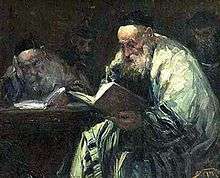Mekhilta of Rabbi Shimon
The Mekhilta de-Rabbi Shimon (Hebrew: מכילתא דרבי שמעון בר יוחאי) is a Halakic midrash on Exodus from the school of R. Akiba, the "Rabbi Shimon" in question being Shimon bar Yochai. No midrash of this name is mentioned in Talmudic literature, but medieval authors refer to one which they call either "Mekilta de-R. Simeon b. Yoḥai," or "Mekilta Aḥrita de-R. Shimon," or simply "Mekilta Aḥeret" = "another mekilta."
References by later writers
From this Mekhilta passages are cited, especially by Naḥmanides in his Pentateuchal commentary on Gen. xlix. 31; Ex. xiv. 19, xxi. 3, xxii. 12; Lev. xxiii. 24; and by R. Todros ha-Levi in his works Sefer ha-Razim and Oẓar ha-Kabod (MSS. in the Königliche Hofund Staatsbibliothek, Munich; comp. M. H. Landauer in Orient, Lit. 1845, vi. 182 et seq.).
Until the early 1900s, aside from these quotations and some given by certain authors of the 16th century, as Elijah Mizraḥi in his commentary on Rashi's commentary on the Pentateuch, R. Shem-Ṭob b. Abraham in his Migdal 'Oz to Maimonides' Yad, and R. Meïr ibn Gabbai in his Tola'at Ya'aḳob (p. 63b, Cracow, 1570), the only other extract of any length from the Mekilta de-R. Shimon which was known was the one published by R. Isaac Elijah Landau from a manuscript of R. Abraham Halami, as an appendix to his edition of the Mekilta (Wilna, 1844).
| Rabbinical Eras |
|---|
There were, therefore, various erroneous opinions regarding this lost work. Zunz (G. V. p. 419, note a) considered it as a cabalistic work ascribed to R. Simeon b. Yoḥai. M. H. Landauer (l.c.) identified it with the Mekilta de-R. Yishmael, while J. Perles (in Monatsschrift, 1858, pp. 145 et seq.) held that the medieval authors applied the name "Mekilta de-R. Shim'on" merely to his maxims which were included in the Mekilta de-R. Yishmael, since separate sentences could be called "mekilta". M. Friedmann was the first to maintain, in his introduction to the Mekilta of R. Ismael (pp. 54 et seq., Vienna, 1870), that, in addition to R. Ishmael's work, there was a halakic midrash to Exodus by R. Simeon, which was called the "Mekilta de-R. Shim'on," and that this Mekilta formed part of the Sifre mentioned in the Talmud Babli (Sanh. 86a; Ber. 47b; Meg. 28b; Ḳid. 49a; Sheb. 41b); Ḥag. 3a).
This assumption of Friedmann's was subsequently confirmed by the publication of a geonic responsum (A. Harkavy, Teshubot ha-Ge'onim, p. 107, No. 229, Berlin, 1888), where a baraita from the Sifre de-Be Rab to Exodus is quoted, which is the same passage as that cited by Naḥmanides from the Mekilta de-R. Shimon b. Yoḥai, in his commentary on Ex. xxii. 12. This extract designates the work of R. Ishmael as the "Mekilta of Palestine," in contradistinction to R. Simeon b. Yoḥai's midrash. It is clear, therefore, that the Mekilta of R. Simeon was implied in the title Sifre de-Be Rab (comp. David Zvi Hoffman, Einleitung in die Halachischen Midraschim, p. 46); and it is mentioned in the Midrash Tehillim (ed. S. Buber, Wilna, 1891), p. 252 (comp. Buber's note there), under the Hebrew name Middot R. Shim'on b. Yoḥai.
It is possible also that Simeon himself intended to refer to his midrash in his saying: "Learn my middot" (Giṭ. 67a). The Judean sources, the Yerushalmi and the haggadic midrashim, introduce baraitot from this Mekilta with the phrase, "Teni R. Shim'on" = "R. Simeon has taught" (comp. Friedmann, introduction to his edition of the Mekilta, pp. 55 et seq.; Hoffmann, l.c. p. 48). The phrase "Tena de-Be R. Shim'on" is extremely rare, however, in Babli, where this midrash ranks as one of the "Sifre de-Be Rab" (Hoffmann, l.c. p. 50). Many sentences of R. Simeon are quoted there in the name of his son Eleazar, so that Hoffmann has very plausibly concluded (l.c. p. 51) that Eleazar edited his father's midrash.
Current status
The Mekilta de-R. Shim'on had disappeared, but some extracts from it were preserved in the collection known as Midrash ha-Gadol, as Israel Lewy first pointed out (Ein Wort über die Mechilta des R. Simon). These fragments were collected by David Zvi Hoffman and published under the title Mechilta des R. Simon b. Jochai in the Hebrew monthly Ha-Peles (vols. i. to iv., passim).
This Mekilta compiled from the Midrash ha-Gadol preserves abundant material from the earliest Scriptural commentaries, quoting, for instance, a sentence from the Doreshe Reshumot on Ex. xxi. 12 (Ha-Peles, iii. 258) which is found nowhere else. It contains also much from post-Talmudic literature (comp. Hoffmann, l.c. p. 387, note 19), for the collector and redactor of the Midrash ha-Gadol had a peculiar way of dressing sentences of such medieval authorities as Rashi, Ibn Ezra, Aruk, and Maimonides in midrashic garb and presenting them as ancient maxims (comp. S. Schechter, Introduction to Midrash ha-Gadol, p. 13, Cambridge, 1902).
A critical version, using newly discovered fragments of texts, was later published by Yaakov Nahum Epstein and his student Ezra Zion Melamed.
Jewish Encyclopedia bibliography
- M. Friedmann, introduction to his edition of the Mekilta, pp. 51-73, Vienna, 1870;
- David Zvi Hoffman, Einleitung in die Halachischen Midraschim, pp. 45-51, Berlin, 1887;
- Israel Lewy, Ein Wort über die Mechilta des R. Simon, Breslau, 1889.
External links
- Jewish Encyclopedia article for Mekhilta de-Rabbi Shimon, by Isidore Singer and Jacob Zallel Lauterbach.
- Mekhilta de-Rabbi Shimon by Epstein
- David Hoffman, Einleitung in hal. Midraschim, freecopy
![]() This article incorporates text from a publication now in the public domain: Jewish Encyclopedia. 1901–1906.
This article incorporates text from a publication now in the public domain: Jewish Encyclopedia. 1901–1906.
